4.3 Different Styles and Models of Journalism
Location, readership, political climate, and competition all contribute to the rapid transformation of journalistic models and writing styles. Over time, however, certain styles—such as sensationalism—have faded or become linked with less serious publications, like tabloids, while others have developed to become prevalent in modern-day reporting. This section explores the nuanced differences among the most commonly used models of journalism.
Objective versus Story-Driven Journalism
In the late 1800s, most publishers believed that they could sell more papers by targeting specific groups. As such, most major newspapers employed a partisan approach to writing, churning out political stories and using news to sway popular opinion. This all changed in 1896 when The New York Times, then a struggling paper, adopted a radical new approach to reporting: employing objectivity, or impartiality, to cater to a wide range of readers.
The Rise of Objective Journalism
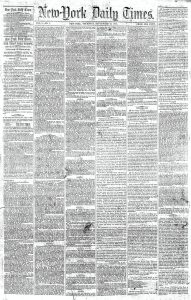
At the end of the 19th century, The New York Times found itself competing with the papers of Pulitzer and Hearst. The paper’s publishers discovered the near impossibility of staying afloat without using the sensationalist headlines popularized by its competitors. Although The New York Times publishers raised prices to pay the bills, the higher charge led to declining readership, and soon the paper went bankrupt. Adolph Ochs, owner of the once-failing Chattanooga Times, took a gamble and bought The New York Times in 1896. On August 18 of that year, Ochs made a bold move and announced that the paper would no longer follow the sensationalist style that made Pulitzer and Hearst famous, but instead would be “clean, dignified, trustworthy and impartial (New York Times, 1935).”
This drastic change proved to be a success. The New York Times became the first of many papers to demonstrate that the press could be “economically as well as ethically successful (New York Times, 1935).” With the help of managing editor Carr Van Anda and lower prices, The New York Times quickly became one of the most profitable impartial newspapers of all time. Since the newspaper’s successful turnaround, publications around the world have followed The New York Times’ objective journalistic style, demanding that reporters maintain a neutral voice in their writing.
The Inverted Pyramid Style
Modern journalists frequently employ the inverted pyramid technique when writing news stories. This style requires objectivity and involves structuring a story so that the author lists the most important details first, making it easier for the reader to follow the narrative. In the inverted pyramid format, the most fundamental facts of a story—typically the who, what, when, where, and why—appear at the top in the lead paragraph, with nonessential information in subsequent paragraphs. The style arose as a product of the telegraph. The inverted pyramid proved useful when telegraph connections failed in the middle of transmission; the editor still had the most critical information at the beginning. Similarly, editors could quickly delete content from the bottom up to meet time and space requirements (Scanlan, 2003).
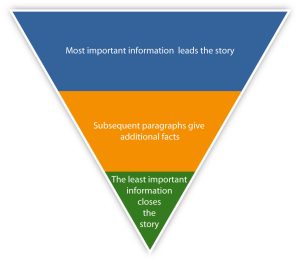
Journalists use this formula for three reasons. First, writers find the style helpful, as this type of reporting helps journalists complete stories within short deadlines, particularly in today’s fast-paced news business. Second, the style benefits editors who can, if necessary, quickly cut the story from the bottom without losing vital information. Finally, the style respects traditional readers, most of whom skim articles or only read a few paragraphs. Based on the structure of the inverted pyramid, these readers can still learn most of the vital information after a quick read.
Interpretive Journalism
During the 1920s, objective journalism came under scrutiny as the world became increasingly complex. Even though The New York Times continued to thrive, readers craved more than dry, objective stories. In 1923, Time magazine launched as the first major publication to depart from simple objectivity, aiming to provide readers with a more nuanced and analytical interpretation of the news. As Time grew, people at other publications took notice, and editors began to slowly rethink how they might reach out to readers in an increasingly interconnected world.
During the 1930s, two major events increased the desire for a new style of journalism: the Great Depression and the Nazi threat to global stability. The who, what, where, when, and why of objective journalism no longer contented readers. Instead, they craved analysis and a deeper explanation of the chaos surrounding them. Many papers responded with a new type of reporting that became known as interpretive journalism.
Interpretive journalism, following Time’s example, has gained popularity since its inception in the 1920s and 1930s. Journalists employ it to explain complex issues and provide readers with a broader context for the stories they encounter. Brant Houston, the executive director of Investigative Reporters and Editors Inc., said an interpretive journalist “goes beyond the basic facts of an event or topic to provide context, analysis, and possible consequences (Houston, 2008).” When this new style debuted, readers responded with great interest to the latest editorial perspectives that newspapers offered on events. However, interpretive journalism presented a new challenge for editors: distinguishing between straight objective news and opinions and analysis. In response, many papers in the 1930s and 1940s “introduced weekend interpretations of the past week’s events…and interpretive columnists with bylines (Ward, 2008).” As explained by Stephen J. A. Ward in his article, “Journalism Ethics,” these weekend features attempted to “supplement objective reporting with an informed interpretation of world events (Ward, 2008).”
Competition From Broadcasting
The 1930s also saw the rise of broadcasting, as radios became common in most U.S. households and sound–picture recordings for newsreels became increasingly prevalent. This broadcasting revolution introduced new dimensions to the field of journalism. Scholar Michael Schudson has noted that broadcast news “reflect[ed]…a new journalistic reality. The journalist, no longer merely the relayer of documents and messages, ha[d] become the interpreter of the news (Schudson, 1982).” However, just as radio furthered the interpretive journalistic style, it also created a new problem for print journalism, particularly newspapers.
Suddenly, free news broadcasts from the radio offered competition to the paid news of newspapers. Scholar Robert W. McChesney has observed that, in the 1930s, “many elements of the newspaper industry opposed commercial broadcasting, often out of fear of losing ad revenues and circulation to the broadcasters (McChesney, 1992).” This fear led to a media war, as papers claimed that radio stations had stolen their print stories. Radio outlets, however, believed they had an equal right to news stories. According to Robert W. McChesney, “commercial broadcasters located their industry next to the newspaper industry as an icon of American freedom and culture (McChesney, 1992).” The debate had a significant impact on interpretive journalism, as radio and newspapers had to decide whether to adopt an objective or interpretive format to remain competitive with one another.
The emergence of television during the 1950s created even more competition for newspapers. In response, paper publishers increased the number of opinion-based articles, and many added what became known as op-ed pages. An op-ed page—short for opposite the editorial page—features opinion-based columns typically produced by a writer or writers unaffiliated with the paper’s editorial board. As op-ed pages grew, so did interpretive journalism. Distinct from news stories, editors and columnists regularly presented their opinions. By the 1960s, the interpretive style of reporting had begun to replace the older descriptive style (Patterson, 2002).
Literary Journalism
Stemming from the development of interpretive journalism, literary journalism emerged during the 1960s. This style, popularized by journalists Tom Wolfe (formerly a strictly nonfiction writer) and Truman Capote, is often referred to as New Journalism and combines factual reporting with sometimes fictional narration. Literary journalism follows neither the formulaic style of objective journalism nor the opinion-based, analytical style of interpretive journalism. Instead, this art form lends voice and character to historical events, focusing on the construction of the scene rather than the retelling of facts.
Important Literary Journalists
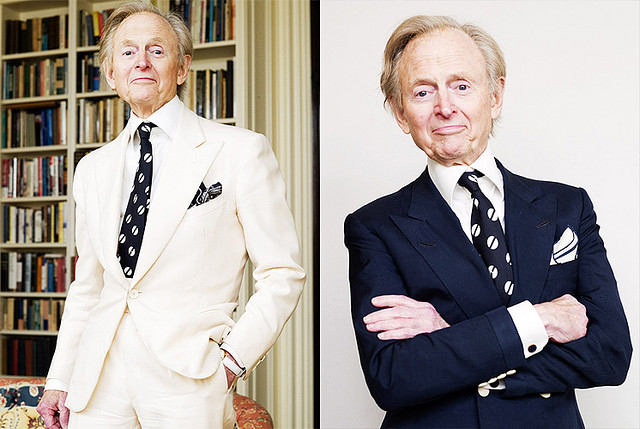
Tom Wolfe first began to write in the literary journalistic style in 1963, when his newspaper, The New York Herald Tribune, went on strike. Esquire magazine hired Wolfe to write an article on customized cars. He gathered details for the story but struggled to turn his collected information into a written piece. His managing editor, Byron Dobell, suggested that he type up his notes so that Esquire could hire another writer to complete the article. Wolfe typed up a 49-page document that described his research and what he wanted to include in the story, and sent it to Dobell. The piece impressed Dobell so much that he deleted the “Dear Byron” at the top of the letter and published the rest of Wolfe’s letter in its entirety under the headline “There Goes (Varoom! Varoom!) That Kandy-Kolored Tangerine-Flake Streamline Baby.” The article achieved great success, and Wolfe, in time, became known as the father of New Journalism. When he later returned to work at the Herald Tribune, Wolfe brought with him this new style, “fusing the stylistic features of fiction and the reportorial obligations of journalism (Kallan, 1992).”
In 1966, Truman Capote responded to Wolfe’s new style by writing In Cold Blood, which Capote termed a “nonfiction novel” (Plimpton, 1966). The tale of an actual murder that had taken place on a Kansas farm some years earlier, Capote based the novel on numerous interviews and painstaking research. Capote claimed that he wrote the book because he wanted to exchange his “self-creative world…for the everyday objective world we all inhabit (Plimpton, 1966).” Critics praised the book for its straightforward, journalistic style. New York Times writer George Plimpton claimed that the book “is remarkable for its objectivity—nowhere, despite his involvement, does the author intrude (Plimpton, 1966).” After In Cold Blood was finished, Capote criticized Wolfe’s style in an interview, commenting that Wolfe “[has] nothing to do with creative journalism” by claiming that Wolfe did not have the appropriate fiction-writing expertise (Plimpton, 1966). Despite the tension between these two writers, they are now remembered for inspiring a similar style in various genres.
When the going gets weird, the weird go pro: New Journalism vs. Hunter S. Thompson’s Gonzo Journalism
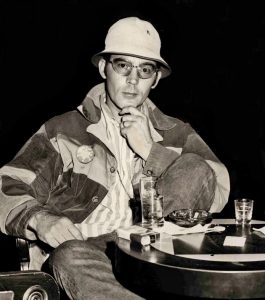
One of the most popular and eccentric journalists of all time, Hunter S. Thompson, developed an offshoot of new journalism referred to as Gonzo Journalism. This style blurred the lines between fiction and non-fiction, injecting the writer’s personal experiences and subjective interpretations into the narrative. It was characterized by a highly stylized first-person perspective, often infused with a humorous and hyperbolic voice. Authors frequently participated in the events being reported and used stream-of-consciousness writing.
Hunter S. Thompson injected a potent dose of subjectivity and first-person experience into the traditionally objective field of journalism. Born in Louisville, Kentucky, in 1937, Thompson’s early career involved stints as a sportswriter and a copyboy, where he honed his writing skills and developed a rebellious streak. His debut novel, Hell’s Angels: The Strange and Terrible Saga of the Outlaw Motorcycle Gangs (1966), resulted from his immersive experience living with and riding alongside the infamous biker gang. This book showcased his unique style – a blend of first-person narrative, social critique, and a disregard for conventional journalistic norms. However, his shorter piece, “The Kentucky Derby is Decadent and Deprived, ” demonstrated his mastery of the form and earned him much acclaim.
Thompson’s most iconic work, Fear and Loathing in Las Vegas (1971), solidified his status as a countercultural icon and cemented Gonzo journalism as his signature style. This semi-autobiographical novel, chronicling a drug-fueled trip through Las Vegas, captured the zeitgeist of the era and showcased Thompson’s ability to blend reportage, social commentary, and hallucinatory prose. Thompson’s writing resonated with the countercultural movements of the 1960s and 70s. His critiques of politics, the American Dream, and societal norms resonated with a generation disillusioned with the status quo.

While Gonzo and New Journalism emerged in the 1960s, challenging traditional journalistic objectivity, key distinctions remain. Both embrace subjectivity, but Gonzo takes it to an extreme. While New Journalism employs literary techniques to engage the reader and offer a more nuanced perspective, Gonzo journalism fully immerses the writer in the story, often to the point of becoming a participant. While not all New Journalists abstained from drug use, it wasn’t a defining characteristic of the style. In Gonzo, drug and alcohol use are often explicitly described and even integral to the narrative, reflecting Thompson’s own experiences and the countercultural ethos of the time.
Thompson’s legacy extends beyond his writing. His larger-than-life persona, fueled by his eccentric behavior and penchant for excess, made him a cultural icon. He ran for sheriff of Aspen, Colorado, on the “Freak Power” ticket (and almost won). His image, featuring aviator sunglasses, a cigarette holder, and a bottle of Wild Turkey, became synonymous with rebelliousness and anti-establishment sentiment.
Though his life was marked by personal struggles and a tragic end, Hunter S. Thompson’s impact on journalism and literature is undeniable. He challenged conventions, pushed boundaries, and gave voice to a generation’s discontent. His Gonzo style, though controversial, remains a powerful reminder that journalism can be a subjective, personal, and even wildly entertaining endeavor.
The Effects of Literary Journalism
Although literary journalism certainly affected newspaper reporting styles, it had a much greater impact on the magazine industry. Because they had fewer restrictions on length and deadlines, magazines had more courage to publish this new writing style than newspapers. Indeed, during the 1960s and 1970s, authors simulating the styles of both Wolfe and Capote flooded magazines such as Esquire and The New Yorker with articles.
Literary journalism also significantly influenced objective journalism. Many literary journalists believed that objectivity limited their ability to critique a story or a writer. Some claim that objective writing remains impossible, as all journalists have their personal histories that may sway their coverage. Still others, including Wolfe, argued that objective journalism conveyed a “limited conception of the ‘facts,’” which “often effected an inaccurate, incomplete story that precluded readers from exercising informed judgment (Kallan).”
Advocacy Journalism and Precision Journalism
The reactions of literary journalists to objective journalism encouraged the growth of two more types of journalism: advocacy journalism and precision journalism. Advocacy journalists promote a particular cause and intentionally adopt a biased, nonobjective viewpoint to do so effectively. However, serious advocate journalists adhere to strict guidelines, as “an advocate journalist is not the same as being an activist” according to journalist Sue Careless (Careless, 2000). In an article discussing advocacy journalism, Careless contrasted the role of an advocate journalist with the role of an activist. She encourages future advocate journalists by saying the following:
A journalist writing for the advocacy press should practice the same skills as any journalist. You don’t fabricate or falsify. If you do you will destroy the credibility of both yourself as a working journalist and the cause you care so much about. News should never be propaganda. You don’t fudge or suppress vital facts or present half-truths (Careless, 2000).
Despite the challenges and potential pitfalls inherent in advocacy journalism, this type of journalism has gained popularity over the past several years. In 2007, USA Today reporter Peter Johnson stated, “Increasingly, journalists and talk-show hosts want to ‘own’ a niche issue or problem, find ways to solve it, and be associated with making this world a better place (Johnson, 2007).” In this manner, journalists worldwide employ the advocacy style to highlight issues they care about.
Beyond the Couch: Oprah’s Reign as Advocacy Journalist
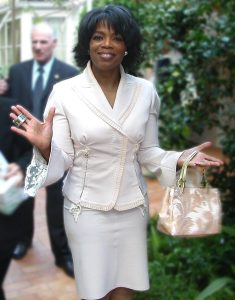
Television talk show host and owner of the production company Harpo Inc., Oprah Winfrey remains one of the most successful and recognizable entrepreneurs of the late 20th and early 21st centuries. Winfrey began as a news reporter in the late 1970s as a co-anchor of an evening television program. She began hosting her show in 1984, and by 2010, the Oprah Winfrey Show was one of the most popular TV programs on the air. Winfrey had long used her show as a platform for issues and concerns, making her one of the most famous advocacy journalists. While many praise Winfrey for using her celebrity to draw attention to the causes she supports, others criticize her techniques, claiming that she employs an advocacy style for self-promotion. As one critic writes, “I’m not sure how Oprah’s endless self-promotion of how she spent millions on a school in South Africa suddenly makes her ‘own’ the ‘education niche.’ She does own the trumpet-my-own-horn niche. But that’s not ‘journalism (Schlussel, 2007).’”
Yet despite this somewhat harsh critique, many view Winfrey as the leading example of positive advocacy journalism. Sara Grumbles claims in her blog “Breaking and Fitting the Mold”: “Oprah Winfrey practices advocacy journalism…. Winfrey does not fit the mold of a ‘typical’ journalist by today’s standards. She has an agenda, and she voices her opinions. She had her op-ed page in the form of a million-dollar television studio. Objectivity is not her strong point. Still, in my opinion she is a journalist (Grumbles, 2007).”
Regardless of the arguments about the value and reasoning underlying her technique, Winfrey unquestionably practices a form of advocacy journalism. Thanks to her vast popularity, she may be the most compelling example of an advocacy journalist working today.
Precision journalism emerged in the 1970s. In this context, journalists often turn to polls and studies to enhance the accuracy of their articles. Philip Meyer, commonly acknowledged as the father of precision journalism, says that he intends to “encourage my colleagues in journalism to apply the principles of scientific method to their tasks of gathering and presenting the news (Meyer, 2002).” This type of journalism adds a new layer to objectivity in reporting, as articles no longer need to rely solely on anecdotal evidence; journalists can employ hard facts and figures to support their assertions. An example of precision journalism would be an article on voting patterns in a presidential election that cites data from exit polls. Precision journalism has gained popularity as computers have become more prevalent. Many journalists currently use this type of writing.
Consensus versus Conflict in Newspapers
Another important distinction within the field of journalism is that between consensus journalism and conflict journalism. Consensus journalism typically occurs in smaller communities, where local newspapers often serve as a forum for diverse voices. Newspapers that employ consensus-style journalism normally include community calendars and meeting notices, as well as articles on local schools, events, government, property crimes, and zoning regulations. These newspapers can help foster civic awareness and a sense of shared experience and responsibility among community readers. Often, business or political leaders in the community own consensus papers.
Conversely, conflict journalism, as presented in national and international news articles in The New York Times, typically appears in national or metropolitan dailies. Conflict journalists define news in terms of societal discord, covering events and issues that contravene perceived social norms. In this style of journalism, reporters act as watchdogs, monitoring the government and its activities. Conflict journalists often present both sides of a story and pit ideas against one another to generate conflict, thereby attracting a larger readership. Both conflict and consensus papers are widespread. However, because they serve different purposes and target different audiences, they largely do not compete with each other.
Niche Newspapers
Niche newspapers represent one more model of newspapers. These publications, which target a specific audience, are gaining popularity in the era of the Internet. As Robert Courtemanche, a certified journalism educator, writes, “In the past, newspapers tried to be everything to every reader to gain circulation. That outdated concept does not work on the Internet, where readers expect expert, niche content (Courtemanche, 2008).” Ethnic and minority newspapers are among the most common forms of niche publications. In the United States, particularly in large cities such as New York, niche papers catering to numerous ethnic communities thrive. Some common types of U.S. niche papers are papers that cater to a specific ethnic or cultural group or to a group that speaks a particular language. Documents that cover issues affecting lesbians, gay men, and bisexual individuals—like The Advocate—and religion-oriented publications—like The Christian Science Monitor—are also niche papers.
The Alternative and Underground Press

The alternative press plays a crucial role in providing a platform for voices and perspectives that are often marginalized or ignored by legacy media outlets. These publications challenge dominant narratives, focus on underrepresented communities, and offer alternative viewpoints on a range of social, political, and cultural issues. Mainstream media, driven by commercial pressures and a desire to reach the widest possible audience, often overlooks or downplays coverage of certain groups or viewpoints. This includes smaller religious groups, alternative political movements, and perspectives challenging the status quo. For instance, during the late 19th century, the Populist Party, a movement advocating for the rights of farmers and workers, enjoyed widespread support despite never winning a primary election. When legacy media outlets failed to adequately cover their platform and concerns, they turned to alternative publications, disseminating their message through over 100 newspapers and journals nationwide. Similarly, the existence of The Daily Worker, a communist newspaper published from 1924 to 1958, demonstrates how the alternative press can provide a platform for even radical or marginalized viewpoints, contributing to a more diverse and inclusive media landscape. Perhaps the most famous alternative newspaper is The Village Voice, New York’s Pulitzer Prize–winning Publication. This newspaper was founded in 1955 and declares its role in the publishing industry by saying:
The Village Voice introduced free-form, high-spirited, and passionate journalism into the public discourse. As the nation’s first and largest alternative newsweekly, the Voice maintains the same tradition of no-holds-barred reporting and criticism it first embraced when it began publishing fifty years ago (Village Voice).
The underground press, a distinct phenomenon of the mid-20th century, flourished particularly in the 1960s and 1970s as a platform for individuals documenting social tensions, inequalities, and countercultural viewpoints. These publications, typically operating on shoestring budgets, were often located in major cities and near college campuses or military bases, serving as a voice for alternative and anti-establishment movements.
Unlike established alternative weeklies like New York’s Village Voice, which focused on cultural and political commentary with wider distribution, the underground press was characterized by its more radical and explicitly anti-establishment stance. The content often included radical political views, experimental writing, and explicit discussions of sexuality and drug use, pushing the boundaries of mainstream norms and legality. The influence of the underground press, particularly its association with the New Left and anti-war movements, concerned the U.S. government, leading the FBI to target these publications as part of its COINTELPRO program, aimed at disrupting political dissent. Despite their limited resources, the underground press played a crucial role in shaping public discourse and giving a voice to marginalized communities during a period of significant social upheaval.

